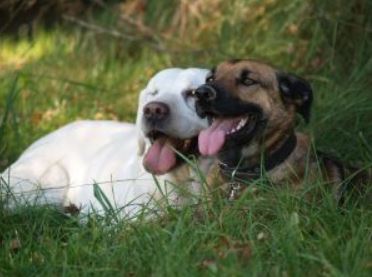Wild dogs grow in flocks and are socialized almost from birth. A dog socializes interacting with other dogs and learning verbal signals and body language. The limits on the pack are very clear and each puppy learns to understand the elders.

Domestic dogs also begin socialization when they are born and when they enter a human family, socialization begins with humans. The initial period of socialization of a dog is four to 12 weeks. It is during this time that social skills are imprinted on them and their interaction with other dogs and humans is, with luck, positive. Socialization must continue into adult life. But many dog owners choose to adopt older dogs that sometimes have not been socialized.
When bringing an adult dog home, it is important to find out just how much he was socialized. His initial interaction with you will show – is he frightened or aggressive? Does it drift away when you approach or send warning signs, as if by creeps? When you take him for a walk, is he nervous about different sounds and visions? Is he intimidated by the presence of people and other dogs? If you find any of these signs, it is likely that he has not been socialized in his early days. But there are many things you can do to socialize an adult dog with other dogs and people.
Socializing an adult dog with other dogs
Go out with your dog to observe
1. Go to a dog park, but do not enter.
2. Let your dog see other dogs and observe their behavior.
3. Whenever a dog approaches, give your dog a reward. This creates a positive association with other dogs.
4. If your dog reacts aggressively to other dogs, move away a little and slowly move until it calms down.
Do not pull the dog while walking
When walking with your dog and another dog approaching, resist pulling on the collar and yelling at him. This reinforces the view of other dogs as a negative experience. Instead, distract your dog with a reward or a toy, use the “Look at me!” Command and praise him when he pays attention to you.
Go to obedience classes
Dog obedience class is a great way to help socialize an adult dog before attempting to take him to dog parks. As your dog is learning commands, he gets distracted most of the time. Talk to your trainer about the problem and he can introduce his dog slowly to other dogs of course. This is also a safe place for your dog to learn how to interact with other humans.
Socializing an adult dog with humans
The first step is to socialize it with your family. It’s best to do this slowly. Patience is a quality here. Dogs and humans speak different languages, so both are learning to communicate.
Ignore your dog
When your dog runs to hide from you, do not go after him or pull him under the bed. Ignore the dog and do something that will convince you to leave, such as playing with your toys, or fry some bacon. Dogs are curious and social creatures, and sometimes they get bored and lonely by themselves. Reward a piece of bacon when it comes out.
Be casual
It’s kind of like when a teenager appears with a pimple on his forehead. You do not talk about it and act like nothing’s wrong. By acting as if your dog’s behavior is not a big deal, you create a quieter environment and a quieter dog. So when he runs to your legs because someone knocks on the door, keep doing your things normally.
Introduce People Slowly
Add up to one person a week into your dog’s life. When you meet him, have him offer a reward and speak with a happy, low, encouraging voice. It is best not to use a strident tone that can stimulate you. Keep the dog on the leash at first, and do not force him to get close to the person. Let him take his own time.
The main thing about socializing an adult dog is being positive and making each experience good with praise and rewards. Fixes do not work well in this case and can create a more nervous dog. Over time, yo
